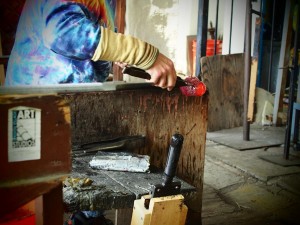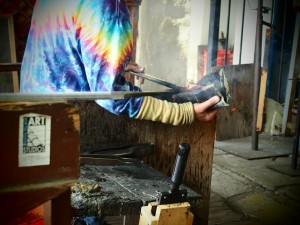Art glass in San Diego

Art glass is an unique and rare medium, and it’s a wonder to watch the creation process.
I had a chance to see live demonstration at Art Glass Festival in San Diego. Glass Artist Kevin Baker put pieces together and said: “Process is difficult and uncertain, but the reward is the birth of a luminescent offspring of fire which serves as a beautiful record of its creation.”
Baker has been experiencing the exhilaration of glassblowing at San Diego’s Spanish Village Art Center in Balboa Park since 2005. You can see him in Studio 19 which opens its doors to the public on Sundays…
“Glass art in general hasn’t changed much over the centuries. Techniques and styles have stood the test of time and are still used in modern glass art studios today.” what he said and continued: “What has changed… or more precisely, evolved… are the tools and materials. Glass artisans can opt for extremely high-tech tools, kilns and furnaces, as well as a vast array of scientifically developed materials for an endless range of uses.”
When I asked about the round mark, he explained the process:
Gather and blow
First gather glass on the end of a pipe. Then blow the glass and shape as desired. At this point the top of the finished vase is connected to the end of the blow pipe.
Transfer
In order to shape the top of the vase, the piece must be transferred to a solid rod called a punty, an “Americanization” of the Italian word pontil (The Italians invented – and named – virtually all modern glass blowing tools and techniques).
To transfer the vase, a small bit of molten glass is gathered on the end of the punty. This is used to “glue” the punty to the bottom of the vase. Then water is dripped on the glass near the blow pipe to chill it and cause the glass to crack. With a sharp tap on the blow pipe the vase breaks away from the pipe and is now attached at the bottom to the punty.
Shape the top
The top of the vase can now be re-heated and shaped to form the neck and lip of the vase. The punty must be kept hot enough to keep the piece attached, but not too hot or it will fuse too strongly to the bottom of the vase.
Break it off
When the vase is finished, a bit of water or a touch with a metal tool is used to chill the punty exactly where it meetsthe bottom of the vase. A sharp tap on the punty rod should cause the vase to crack off, hopefully without damaging the vase!
The mark that is left where the punty was attached can be fire-polished before the vase is put into the annealler, or “cold worked” later after the piece has completely cooled.
Many glass artists will grind and polish the bottom of their work to erase the punty mark, but I do not.
I consider it to be the “belly button” of the piece, which proves that it was “birthed” by hand, not manufactured by a machine. Machine made glass does not have a punty mark because a punty is not used to make a machine blown-piece.
You can watch art in action every day and also take glassbolwing lessons…
For more info: http://spanishvillageart.com/
You can see some of my photography when Kevin Baker is in action:





















